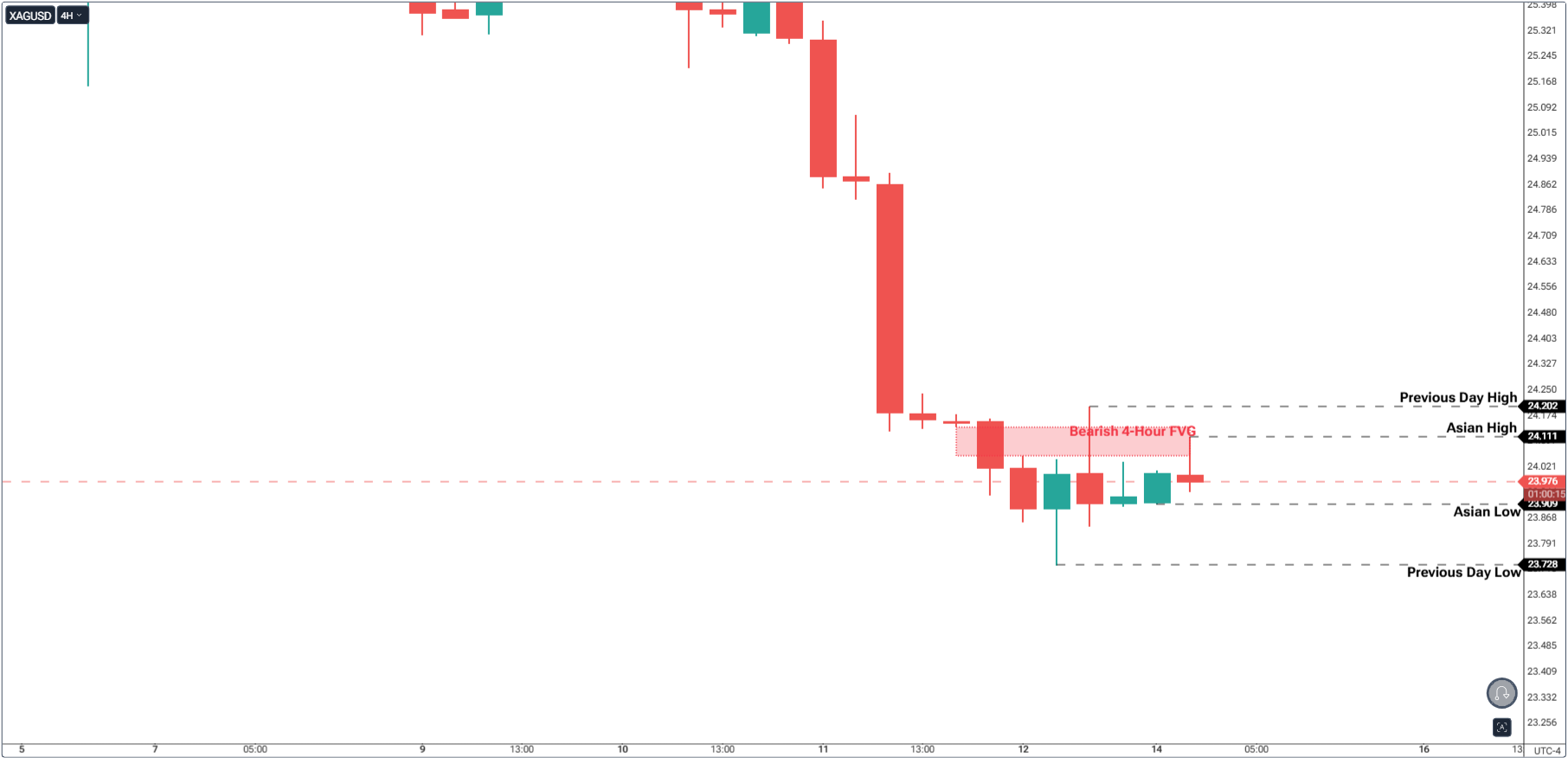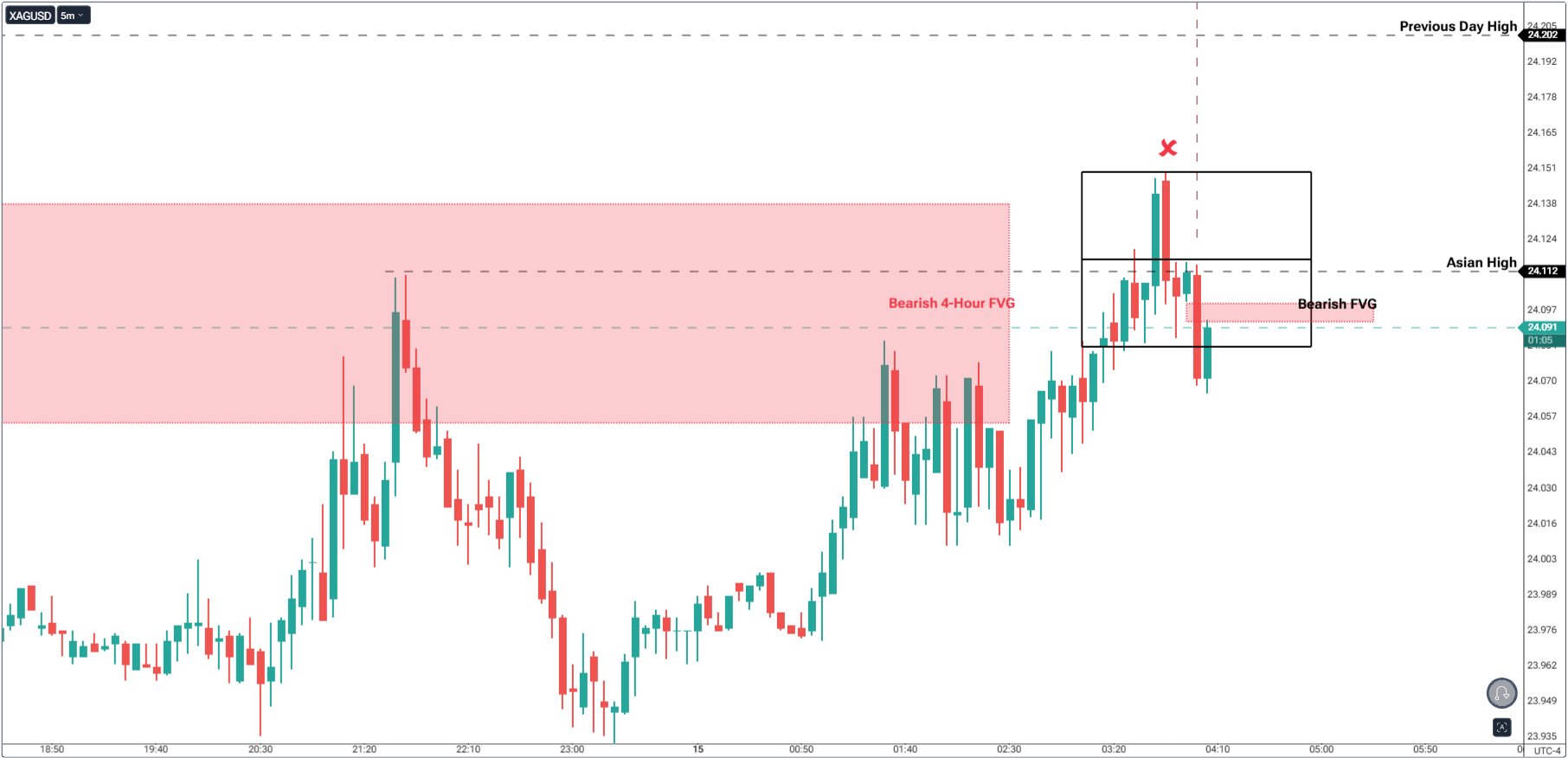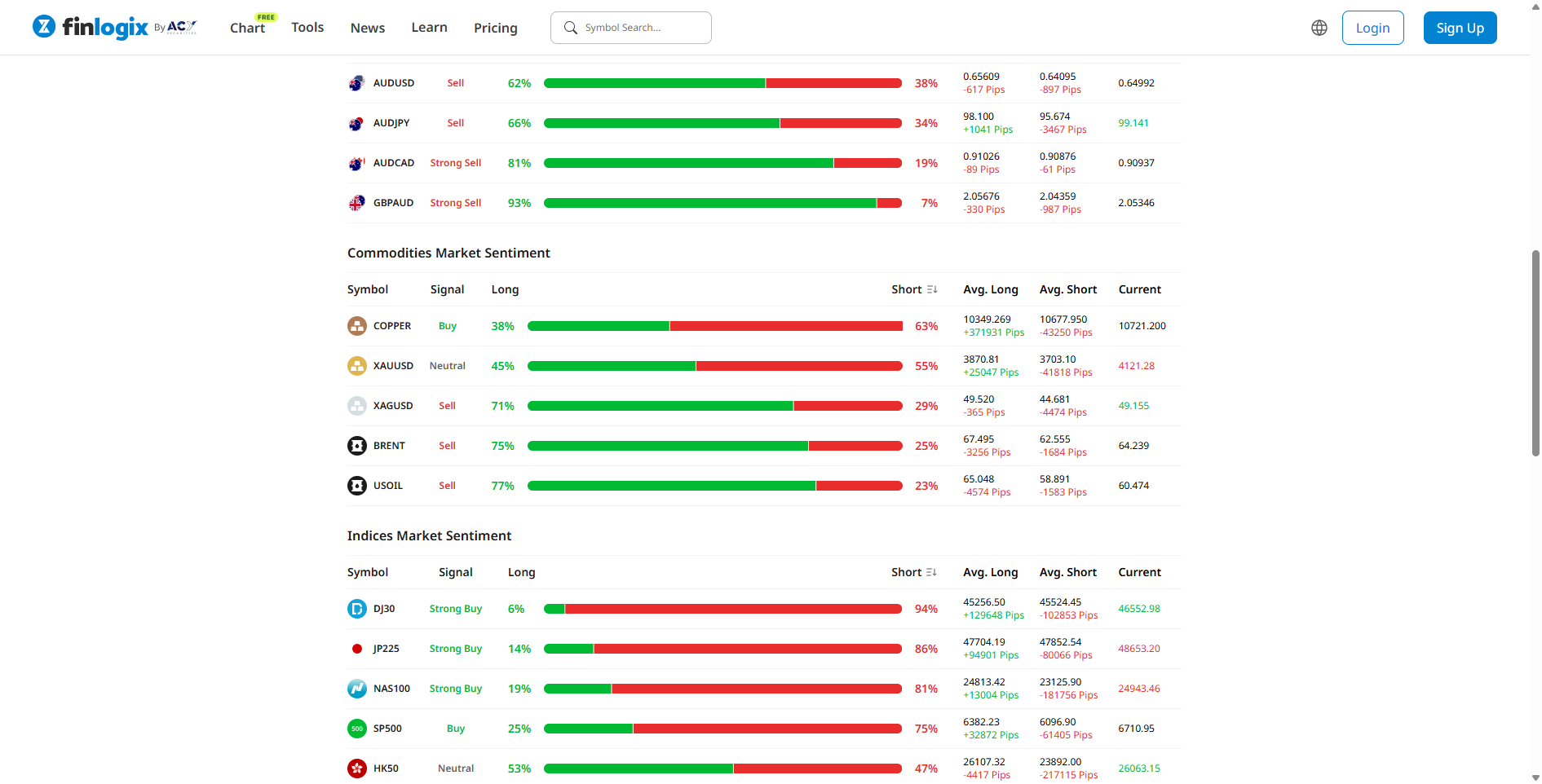How to Day Trade Silver Like a Pro: Smart Money Tactics for XAG/USD
2025-10-23 14:48:47
If you’ve been watching the metals market lately, you’ll notice something interesting-while gold steals the headlines, silver is quietly catching fire. As gold continues testing record highs, traders are hunting for an alternative with similar macro drivers but smaller contract sizes and punchier intraday swings-exactly why silver (XAG/USD) is becoming the go-to. Silver isn’t just “gold’s little brother.” With thinner liquidity, faster swings, and strong ties to industrial demand, it reacts quickly when the US dollar and yields shift-giving day traders cleaner opportunities when they have a confirmation-based plan.

In this guide, you’ll learn how to day trade silver using Smart Money Concepts (SMC)-focusing on liquidity zones, market structure, and institutional footprints, plus the best trading windows and how commodity exchange opens amplify liquidity.
Understanding Silver’s Personality
Silver plays a dual role-both precious and industrial-so it moves with safe-haven flows and growth cycles. When global growth expectations rise, silver often rallies with risk assets; when fear takes over, gold tends to lead while silver lags. That duality is why your plan needs clear confirmation rather than opinions. If you’re new to sentiment shifts, this quick primer on risk-on vs risk-off will help you frame silver’s behavior across regimes.
Why the London–US Overlap Is the Best Time to Trade Silver

The London and New York overlap (8:00 AM–12:00 PM NY time) is where silver truly comes alive:
- Volume convergence: European bullion banks and funds meet US futures flow on COMEX, creating peak liquidity and clean reactions at levels. To anticipate the morning play, study London session dynamics and how Smart Money often sets the day’s high or low.
- News catalysts: US macro prints like CPI or claims drop during this window, shaking the dollar and metals simultaneously. Pair your read with technical confirmation, not headlines alone.
- Transition flows: London’s close and NY’s fresh orders often trigger liquidity hunts and structural breaks-ideal conditions for SMC models. For the second half of the window, this New York session guide shows what typically unfolds.
How Commodity Exchange Openings Boost Liquidity
Silver futures trade primarily on COMEX. When the COMEX metals pit opens at 8:20 AM ET, queued orders from the overnight session hit the book, market makers hedge, and spot XAG/USD syncs with futures. That’s why you often see sharp sweeps, displacement candles, and tight Fair Value Gaps around the open. Treat that burst as a setup window, not a reason to chase. If you need a refresher on the footprint you’re hunting, review liquidity sweeps and Fair Value Gaps-these are your bread-and-butter tells.
Step-By-Step Guide to Day Trade Silver
Step 1: Mark Key Liquidity Zones

Identify magnets where stops usually rest:
- Previous day’s high or low
- Previous week’s high or low
- Previous Session high or low
- Major equal highs or equal lows
- H1/H4/Daily Fair Value Gaps
Wait for a sweep of one of these pools, then a displacement in the opposite direction. This is your first “the market just ate stops” signal. If you’re building routine around this, integrate a simple pre-market flow from this day-trading routine guide to keep your process tight.
Step 2: Align With Higher Timeframe Bias

Use H4 and H1 to define directional context:
- Bullish: higher highs and higher lows
- Bearish: lower highs and lower lows
- Range: treat edges as liquidity magnets
Trade in the direction of the recent displacement on H1–H4. If the higher timeframe is bullish and Asia sweeps downside liquidity, you’re hunting longs once structure flips back up.
In this case, we are seeing that overall, Silver is on a bearish environment. Hence, we’d like to look for shorts more instead of longs.
Step 3: Confirm the Entry – MSS + FVG Return
Your confirmation stack:
1. Sweep of a key level

2. Displacement breaking near-term structure

3. FVG left by that impulse

4. Return to FVG for entry with a tight stop

This is the classic SMC sequence. If you want a compact checklist for execution, combine it with the London session playbook and the New York session mapping above.
Target the next key level: Asian Low
Step 4: Understand Fundamental Drivers
Intraday silver reacts to:
- US Dollar Index and yields
- Risk appetite vs fear
- Manufacturing and inflation data

Sentiment dashboards help, but treat them as lagging. Use Finlogix Sentiment to gauge positioning, then wait for price-action confirmation via the MSS + FVG model.
Step 5: Manage Risk and Emotions
Volatility is a gift only if you cap the downside. Keep it simple:
- Risk per trade: max 1%
- Daily loss cap: 2–3%
- Stops go beyond structure, not round numbers
- Targets: next liquidity pool or FVG
If you need a one-stop refresher, this risk management foundation covers SL, TP, and sizing in plain English.
Real-Life Analogy: The Surfer and the Wave

A great surfer studies the sets, waits for the break, and commits when the wave forms-not before. Day trading silver is the same: wait for the sweep, the power shift, and the FVG pullback. Jump early and you wipe out; jump late and you miss the ride.
When to Stand Aside
- The hour before high-impact US data
- Late US afternoon and most of Asia session
- After parabolic moves that need rebalancing
Not taking a trade is still a professional decision.
Final Thoughts
Silver rewards timing, patience, and structure. Focus on the windows where liquidity is thickest-London–US overlap and COMEX open-then trade the sweep, displacement, and FVG return. Keep risk small, decisions clean, and process repeatable.
FAQs
1. Best timeframe stack?
M15 for bias, M5 for context, M1 for precision around the FVG.
2. Minimum capital?
You can start small-risk 1% or less while you build data and discipline.
3. Is silver harder than gold?
It’s faster and whip-sier, but the confirmation model evens the playing field.
4. How do I keep consistent?
Build a routine around session timing and one setup. This simple routine pairs well with the SMC stack.
Start Practicing with Confidence - Risk-Free!
- Trade forex, indices, gold, and more
- Access ACY, MT4, MT5, & Copy Trading Platforms
- Practice with zero risk
It’s time to go from theory to execution - risk-free.
Create an Account. Start Your Free Demo!
Check Out My Contents:
Strategies That You Can Use
Looking for step-by-step approaches you can plug straight into the charts? Start here:
- How To Trade & Scalp Indices at the Open Using Smart Money Concepts (SMC)
- How to Trade Breakouts Effectively in Day Trading with Smart Money Concepts
- Complete Step-by-Step Guide to Day Trading Gold (XAU/USD) with Smart Money Concepts (SMC)
- The Power of Multi-Timeframe Analysis in Smart Money Concepts (SMC)
- Forex Trading Strategy for Beginners
- Mastering Candlestick Pattern Analysis with the SMC Strategy for Day Trading
- How to Use Fibonacci to Set Targets & Stops (Complete Guide)
- RSI Divergence Trading Strategy for Gold: How to Identify and Trade Trend Reversals
- Stochastics Trading Secrets: How to Time Entries in Trending Markets using Stochastics
- Gold Trading Stochastics Strategy: How to Trade Gold with 2R - 3R Targets
- RSI Hidden Divergence Explained: How to Spot Trend Continuations Like a Pro
- Moving Averages Trading Strategy Playbook
- Mastering Fibonacci Trading Psychology - Trusting the Levels, Managing the Mind
- Mastering Price Action at Key Levels - How to Spot, Trade, and Win at the Most Crucial Zones
- Mastering Retests: How to Enter with Confirmation After a Breakout
Indicators / Tools for Trading
Sharpen your edge with proven tools and frameworks:
- The Ultimate Guide to Risk Management in Trading - A Complete Compilation for 2025
- Moving Averages Trading Strategy Playbook
- How to Think Like a Price Action Trader
- Mastering Fibonacci Trading Psychology - Trusting the Levels, Managing the Mind
How To Trade News
News moves markets fast. Learn how to keep pace with SMC-based playbooks:
- Why Smart Money Concepts Work in News-Driven Markets - CPI, NFP, and More
- How to Trade NFP Using Smart Money Concepts (SMC) - A Proven Strategy for Forex Traders
- How to Trade CPI Like Smart Money - A Step-by-Step Guide Using SMC
Learn How to Trade US Indices
From NASDAQ opens to DAX trends, here’s how to approach indices like a pro:
- How to Start Trading Indices and Get into the Stock Market with Low Capital (2025 Guide)
- Best Indices to Trade for Day Traders | NASDAQ, S&P 500, DAX + Best Times to Trade Them
- How To Trade & Scalp Indices at the Open Using Smart Money Concepts (SMC)
- NAS100 - How to Trade the Nasdaq Like a Pro (Smart Money Edition)
How to Start Trading Gold
Gold remains one of the most traded assets - here’s how to approach it with confidence:
- How to Swing Trade Gold (XAU/USD) Using Smart Money Concepts: A Simple Guide for Traders
- Complete Step-by-Step Guide to Day Trading Gold (XAU/USD) with Smart Money Concepts (SMC)
- The Ultimate Guide to Backtesting and Trading Gold (XAU/USD) Using Smart Money Concepts (SMC)
- Why Gold Remains the Ultimate Security in a Shifting World
- How to Exit & Take Profits in Trading Gold Like a Pro: Using RSI, Range Breakdowns, and MAs as Your Confluence
How to Trade Japanese Candlesticks
Candlesticks are the building blocks of price action. Master the most powerful ones:
- Mastering the Top Japanese Candlesticks: The Top 5 Candlesticks To Trade + Top SMC Candlestick Pattern
- How to Trade Candlestick Patterns with High Probability: A Complete Guide for Beginners
- The Top Japanese Candlestick Guide: What is an Engulfing Pattern and How to Trade It?
- Piercing Pattern Candlestick Explained: How to Trade It - Step-By-Step Guide
- Morning & Evening Star Candlestick Patterns - How to Trade Market Reversals with Confidence
How to Start Day Trading
Ready to go intraday? Here’s how to build consistency step by step:
- 5 Steps to Start Day Trading: A Strategic Guide for Beginners
- 8 Steps How to Start Forex Day Trading in 2025: A Beginner’s Step-by-Step Guide
- 3 Steps to Build a Trading Routine for Consistency and Discipline - Day Trading Edition
- The Ultimate Guide to Understanding Market Trends and Price Action
- Trading with Momentum: The Best Trading Session to Trade Forex, Gold and Indices
Swing Trading 101
- Introduction to Swing Trading
- The Market Basics for Swing Trading
- Core Principles of Swing Trading
- The Technical Foundations Every Swing Trader Must Master
- Swing Trader’s Toolkit: Multi-Timeframe & Institutional Confluence
- The Psychology of Risk Management in Swing Trading
- Swing Trading Concepts To Know In Trading with Smart Money Concepts
- Becoming a Consistent Swing Trader: Trading Structure & Scaling Strategy
Learn how to navigate yourself in times of turmoil
Markets swing between calm and chaos. Learn to read risk-on vs risk-off like a pro:
- How to Identify Risk-On and Risk-Off Market Sentiment: A Complete Trader’s Guide
- How to Trade Risk-On and Risk-Off Sentiment - With Technical Confirmation
- The Ultimate Guide to Understanding Market Trends and Price Action
- Metals in Risk-On and Risk-Off Environments: How Sentiment Moves Gold and Commodities
Want to learn how to trade like the Smart Money?
Step inside the playbook of institutional traders with SMC concepts explained:
- Why Smart Money Concepts Work: The Truth Behind Liquidity and Price Action
- Mastering the Market with Smart Money Concepts: 5 Strategic Approaches
- Understanding Liquidity Sweep: How Smart Money Trades Liquidity Zones in Forex, Gold, US Indices
- The SMC Playbook Series Part 1: What Moves the Markets? Key Drivers Behind Forex, Gold & Stock Indices
- The SMC Playbook Series Part 2: How to Spot Liquidity Pools in Trading - Internal vs External Liquidity Explained
- Fair Value Gaps Explained: How Smart Money Leaves Footprints in the Market
- Accumulation, Manipulation, Distribution: The Hidden Cycle That Runs Every Market
- Institutional Order Flow - Reading the Market Through the Eyes of the Big Players
- London Session Trading Secrets: How Smart Money Sets the High & Low of the Day
- Mastering the New York Session - Smart Money Concepts Guide
Master the World’s Most Popular Forex Pairs
Forex pairs aren’t created equal - some are stable, some are volatile, others tied to commodities or sessions.
- The Top 5 All-Time Best Forex Pairs to Trade
- Top Forex Pairs Beyond the Big Five
- EUR/USD: The King of Forex
- USD/JPY: The Fast Mover
- GBP/USD: The Volatile Cable
- AUD/USD: The Commodity Currency
- USD/CAD: The Oil-Backed Pair
- GBP/JPY: How to Trade The Beast
- Asian & London Session Secrets
- Mastering the New York Session
Metals Trading
- Metals Trading: Why Gold and Metals Are Rising Again
- Silver Trading: The Underdog with Dual Identity
- Gold vs Silver: Institutional Demand Breakdown Explained
- Platinum & Palladium: The Quiet Power Duo of Industrial Metals
Stop Hunting 101
If you’ve ever been stopped out right before the market reverses - this is why:
- Stop Hunting 101: How Swing Highs and Lows Become Liquidity Traps
- Outsmarting Stop Hunts: The Psychology Behind the Trap
- How to Lessen Risk From Stop Hunts in Trading
- How Stop Hunts Trigger Revenge Trading - Breaking the Pain Cycle
- How to Accept Stop Hunts Without Losing Discipline - Shifting From Frustration to Focus
Trading Psychology
Mindset is the deciding factor between growth and blowups. Explore these essentials:
- The Mental Game of Execution - Debunking the Common Trading Psychology
- Managing Trading Losses: Why You Can Be Wrong and Still Win Big in Trading
- The Hidden Threat in Trading: How Performance Anxiety Sabotages Your Edge
- Why 90% of Retail Traders Fail Even with Profitable Trading Strategies
- Top 10 Habits Profitable Traders Follow Daily to Stay Consistent
- Top 10 Trading Rules of the Most Successful Traders
- Top 10 Ways to Prevent Emotional Trading and Stay Disciplined in the Markets
- Why Most Traders Fail - Trading Psychology & The Hidden Mental Game
- Emotional Awareness in Trading - Naming Your Triggers
- Discipline vs. Impulse in Trading - Step-by Step Guide How to Build Control
- Trading Journal & Reflection - The Trader’s Mirror
- Overcoming FOMO & Revenge Trading in Forex - Why Patience Pays
- Risk of Ruin in Trading - Respect the Math of Survival
- Identity-Based Trading: Become Your Trading System for Consistency
- Trading Psychology: Aligning Emotions with Your System
- Mastering Fear in Trading: Turn Doubt into a Protective Signal
- Mastering Greed in Trading: Turn Ambition into Controlled Growth
- Mastering Boredom in Trading: From Restless Clicking to Patient Precision
- Mastering Doubt in Trading: Building Confidence Through Backtesting and Pattern Recognition
- Mastering Impatience in Trading: Turn Patience Into Profit
- Mastering Frustration in Trading: Turning Losses Into Lessons
- Mastering Hope in Trading: Replacing Denial With Discipline
- When to Quit on Trading - Read This!
- The Math of Compounding in Trading
- Why Daily Wins Matter More Than Big Wins
- Scaling in Trading: When & How to Increase Lot Sizes
- Why Patience in Trading Fuels the Compounding Growth
- Step-by-Step Guide on How to Manage Losses for Compounding Growth
- The Daily Habits of Profitable Traders: Building Your Compounding Routine
- Trading Edge: Definition, Misconceptions & Casino Analogy
- Finding Your Edge: From Chaos to Clarity
- Proving Your Edge: Backtesting Without Bias
- Forward Testing in Trading: How to Prove Your Edge Live
- Measuring Your Edge: Metrics That Matter
- Refining Your Edge: Iteration Without Overfitting
- The EDGE Framework: Knowing When and How to Evolve as a Trader
- Scaling Your Edge: From Small Account to Consistency
Market Drivers
- Central Banks and Interest Rates: How They Move Your Trades
- Inflation & Economic Data: CPI Trading Strategy and PPI Indicator Guide
- Geopolitical Risks & Safe Havens in Trading (Gold, USD, JPY, CHF)
- Jobs, Growth & Recession Fears: NFP, GDP & Unemployment in Trading
- Commodities & Global Trade: Oil, Gold, and Forex Explained
- Market Correlations & Intermarket Analysis for Traders
Risk Management
The real edge in trading isn’t strategy - it’s how you protect your capital:
- Mastering Risk Management: Stop Loss, Take Profit, and Position Sizing
- Why Risk Management Is the Only Edge That Lasts
- How Much Should You Risk per Trade? (1%, 2%, or Less?)
- The Ultimate Risk Management Plan for Prop Firm Traders - Updated 2025
- Mastering Position Sizing: Automate or Calculate Your Risk Like a Pro
- Martingale Strategy in Trading: Compounding Power or Double-Edged Sword?
- How to Add to Winners Using Cost Averaging and Martingale Principle with Price Confirmation
Suggested Learning Path
If you’re not sure where to start, follow this roadmap:
- Start with Trading Psychology → Build the mindset first.
- Move into Risk Management → Learn how to protect capital.
- Explore Strategies & Tools → Candlesticks, Fibonacci, MAs, Indicators.
- Apply to Assets → Gold, Indices, Forex sessions.
- Advance to Smart Money Concepts (SMC) → Learn how institutions trade.
- Specialize → Stop Hunts, News Trading, Turmoil Navigation.
This way, you’ll grow from foundation → application → mastery, instead of jumping around randomly.
Follow me for more daily market insights!
Jasper Osita - LinkedIn - FXStreet - YouTube
This content may have been written by a third party. ACY makes no representation or warranty and assumes no liability as to the accuracy or completeness of the information provided, nor any loss arising from any investment based on a recommendation, forecast or other information supplies by any third-party. This content is information only, and does not constitute financial, investment or other advice on which you can rely.
Try These Next
4 Powerful Tactics to Overcome the Most Costly Forex Mistakes
How to Master MT4 & MT5 - Tips and Tricks for Traders
The Importance of Fundamental Analysis in Forex Trading
Forex Leverage Explained: Mastering Forex Leverage in Trading & Controlling Margin
The Importance of Liquidity in Forex: A Beginner's Guide
Close All Metatrader Script: Maximise Your Trading Efficiency and Reduce Stress
Best Currency Pairs To Trade in 2025
Forex Trading Hours: Finding the Best Times to Trade FX
MetaTrader Expert Advisor - The Benefits of Algorithmic Trading and Forex EAs
Top 5 Candlestick Trading Formations Every Trader Must Know















